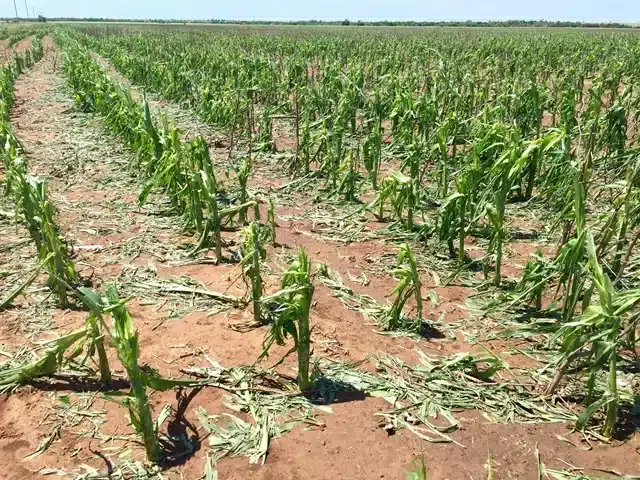In the summer months, disaster management teams have their hands full as storms rip through areas of South Africa that get summer rainfall. Although most farmers celebrate the rain, hail in South Africa can cause extensive damage to crops and livelihoods.
According to a new report from global change expert Nicholas King, the impact of climate change in South Africa will be significant. King reports that South Africa is set to suffer enormous negative ecological, physical and socioeconomic harm under all climate scenarios. These include extreme weather events, extreme heat stress, food insecurity, crop failures, water and social conflict.
In areas of climate warming and increasing water stress, it’s likely that the rainfall that does arrive will come in extreme events such as hail storms and tornadoes. Increased incidences of extreme weather events have been causing widespread damage and loss to the agricultural sector, particularly over the past decade.
Like most risks to farming and food security, mitigating and dealing with these events starts with preparing and improving plant nutrient availability. In this blog, we detail how to remedy or mitigate damage to crops caused by hail.
Where does hail occur in South Africa?
South Africa is home to hailstorm ‘hotspots’ or ‘hail belts’—areas that have a much higher hailstorm frequency than the surrounding areas. These areas include:
- The Misgund area in the Langkloof Valley, one of South Africa’s main deciduous fruit production areas
- The southern slopes of the Winterberg Mountains in the Eastern Cape from north of Somerset East to the north of Fort Beaufort
- The Kat River Valley where the citrus farmers have suffered great losses due to regular severe hailstorms
Even if your farm is not in a typical hail hotspot, this doesn’t mean that you can become complacent, since even one hailstorm can have a serious impact on crop production. In addition, weather patterns around the country are changing due to the effects of climate change.
How often does it hail in South Africa?
Statistics show that certain areas in Gauteng, the eastern Free State, KwaZulu Natal and Mpumalanga have on average 6–8 hail days a year. The occurrence of hail in South Africa decreases in coastal areas as well as the western part of the country, where more than one hail day a year is uncommon. The higher-lying regions in the country, with summer rainfall, are at a higher risk of hailstorms. Hailstones are formed as moisture rises and freezes, such as against the side of a mountain. Therefore, mountainous regions, such as those around the Drakensburg mountains, as well as smaller mountain ranges, have the highest occurrence of hail.
How does hail affect agricultural production?
The effect of even a single hailstorm can have a major economic impact on agricultural production globally. Hail in South Africa is no different. The timing of a hailstorm, in relation to the crop stage, can have a substantial influence on the destruction caused. Considerable damage can occur when young plants are not sturdy or strong enough yet to withstand the hailstones. This could mean significant yield loss or even the end of the growing season for certain farmers.
What happens when crops are hit by hail?
Severe hailstorms destroy crops, kill people and livestock, and damage homes and buildings.
Along with the visible damage to the plant, any crop affected by hail will have its ability to photosynthesise compromised. Photosynthesis is the process that fuels the plant’s growth process and ensures an efficient immune system.
Major contributors to a healthy plant are the metabolites (from photosynthesis) that are sent back down via the roots into the rhizosphere (the film between the soil particle and the root hair). These exudates primarily take the form of carbohydrates (simple and complex sugars) that serve as a food source to the complex array of microbes that perform different functions which are essential to the survival of the plant. One of these is the solubilisation of essential nutrients (such as phosphate) to make them available to the plant.
If crops have been shredded by hail, photosynthesis can’t happen effectively. The compromised plant becomes susceptible to disease, and its health will experience a general downward spiral.
How can hail-damaged crops be rejuvenated?
When your body feels rundown (caused by stress like lack of sleep, extreme cold or heat or intense physical activity), you may take a vitamin C or immune supplement to avoid getting sick. Similarly, plants affected by hail can benefit from a foliar application of a product such as Nutri-Tech Triple Ten™.
What is Nutri-Tech Triple Ten™?
Combining conventional and organic properties, Nutri-Tech Triple Ten™ is a liquid fertiliser that acts as a boost for plants in stress situations such as hail damage. This tried-and-tested product helps stressed plants access nutrients that they have not been able to generate through their own natural “factory”, photosynthesis.
A boost for plant recovery plus peak health and quality
Within the context of varied and unpredictable climatic circumstances and seasonal conditions, Nutri-Tech Triple Ten™ offers farmers, landscapers, and gardeners a simple and effective solution to the adverse effects of stress conditions, as well as an easy day-to-day boost to achieving premium-quality plant health and produce.
The brix level of a plant that has been stressed will always be much lower than one that is healthy. A refractometer (a device that measures brix in the sap of a plant) is a simple mechanism that will show higher brix levels after the application of Nutri-Tech Triple Ten™.
READ MORE ABOUT BRIX LEVELS IN PLANTS
Where can Nutri-Tech Triple Ten™ be applied?
- All crops
- Vineyards
- Turf
- Orchards
- Ornamental gardens
How is it applied?
Nutri-Tech Triple Ten™ is applied primarily as a foliar spray (not recommended until seedlings are 15cm high) or through irrigation systems.
How does Nutri-Tech Triple Ten™ work?
Nutri-Tech Triple Ten™ works by providing additional nutrients taken up by the leaves as opposed to through the root system. As a foliar feed, the nutrients are more easily taken up and metabolised than through the more complex root applications, removing the impediment of unavailable elements in the soil.
A multi-pronged approach
As is often the case when nursing a sick plant (or human) to good health, a multi-pronged, holistic approach generally yields the best results.
The addition of Sea Brix™ can further magnify the effect of Nutri-Tech Triple Ten™ when applied to damaged crops. The combination of the broad spectrum of inorganic nutrients in Nutri-Tech Triple Ten™ is supported by the amino acids, kelp and triacontanol (a catalyst in the photosynthetic process) in Sea Brix™.
You may also be interested in:
Benefits of Nutri-Tech Triple Ten™ application include:
- Healthy, vigorous growth
- Improved root structure
- More even fruit size and better colour
- Early maturity
- Increased yield and quality
- Better taste and shelf life
- Broad-spectrum nutrition and plant growth promotion.
- Combining conventional and organic properties, Nutri-Tech Triple Ten™ can be used as part of your regenerative farming strategy. Discover your crop’s recovery, resilience, and health promotion strategy with Nutri-Tech Triple Ten™. The team at Zylem are on hand to explain applications and precautions associated with this product and many others.
Get in touch to find out more about our plant health services and solutions.

About the Author: Alex Platt
Alex is Business Development Manager at Zylem. He’s inspired by the potential of regenerative farming and takes a special interest in the technology and products that are moving agriculture in a more sustainable direction.

